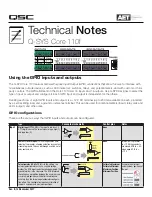
Technical
Notes
Q-SYS Core 110f
Rev. B, 14 November 2017
Using the GPIO inputs and outputs
The Q-SYS Core 110f features General Purpose Input/Output (GPIO) connections that allow the core to interface with
miscellaneous outside devices, such as LED indicators, switches, relays, and potentiometers, and with custom or third-
party controls. The GPIO allotment on the Core 110f totals 16 inputs and 16 outputs. Use Q-SYS Designer to select the
type of input or output and configure it. Each GPIO input and output is independent of the others.
Flanking each row of eight GPIO inputs and outputs is a +12 V DC terminal (up to 200 mA available on each, protected
by a self-resetting fuse) and a ground or reference terminal. This can be used for potentiomenters (input), relay coils and
LEDs (output), and other uses.
GPIO configurations
These are the various ways that GPIO inputs and outputs can be configured.
Type
Conceptual schematic
Control pins
Notes
Input
Digital Input (TTL 3.3 V)—
The input is fed by a 3.3
V TTL digital source. The two states are logic high (1)
and logic low (0).
None
Contact Closure Input—
This setting enables an in-
ternal pull-up resistor, allowing actuation by a contact
closure to ground. This can be through a switch, set of
relay contacts, etc.
None
Internal pull-up resistor
to +12 V. When contacts
are closed, GPIO In = 0 V;
when open, GPIO In =
+12 V.
Potentiometer (10 kΩ, 12 V)—
In this setting, the
external potentiometer acts as a variable voltage
divider. The GPIO input reads the voltage delivered. The
ground terminal is the reference. The GPIO interprets
the voltage as a proprtion between the minimum and
maximum pot positions, with better resolution and
accuracy than the two-wire potentiometer configura-
tion offers. This configuration requires calibration of
the pot’s minimum and maximum positions.
Calibrate Maximum
Calibrate Minimum
Maximum Position
Minimum Position
Calibrate the minimum
and maximum positions of
the pot.




















